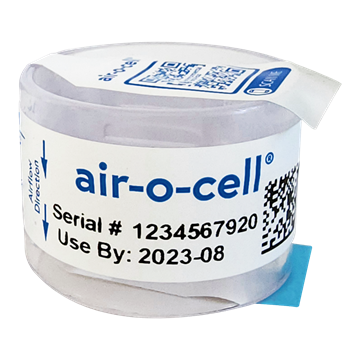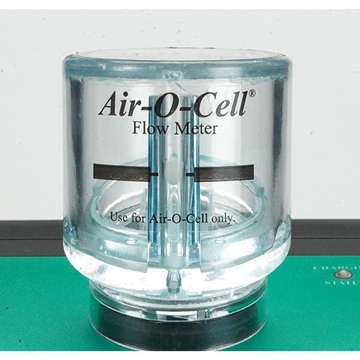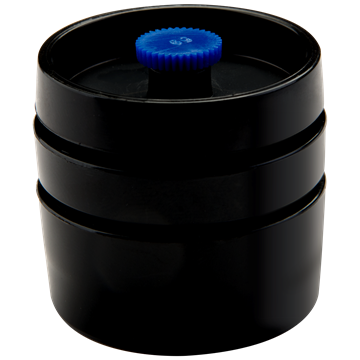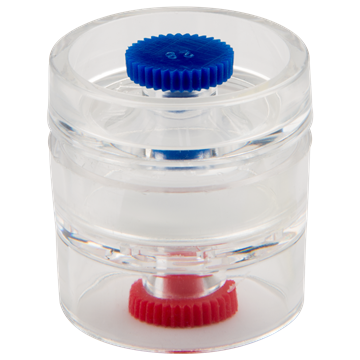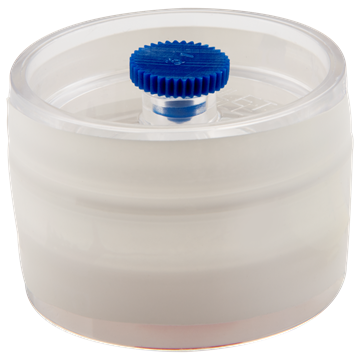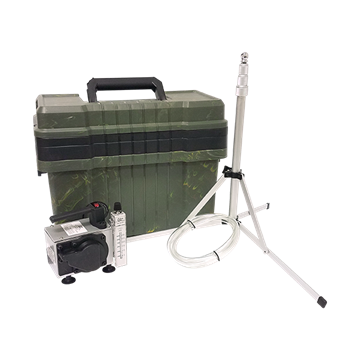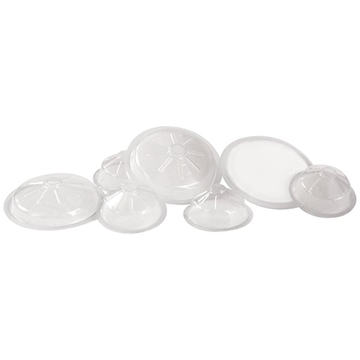
If you've ever watched Mad Men or any other TV show about the '50s, you're probably familiar with scenes of smoke-filled offices and lounge spaces. While these environments might set a good scene for films, they're certainly not suitable conditions for working.
Though rampant smoking is less of a problem today, poor air quality at work remains a vital issue to address.
Many workers spend 40 hours a week indoors, in the close quarters of offices or cubicles. With so much time spent at the office, a healthy indoor environment is essential. Air quality is important to employees' health, comfort, well-being, morale and productivity.
It's essential for employers to be proactive and take steps to identify potential air quality problems before they lead to discomfort and illness. Below we've outlined how to take proactive measures and comply with OSHA air quality regulations.
Table of Contents
- What Is Indoor Air Quality, and Why Is It Important?
- What is Considered Good Indoor Air Quality in the Workplace?
- What Are the Most Common Causes of Poor Indoor Air Quality?
- What Are OSHA IAQ Standards?
- General Duty Clause
- OSHA PELs
- What Are the Consequences of Poor Indoor Air Quality?
- How Can I Tell if There Is an Indoor Air Quality Problem in My Workplace?
- How to Find Indoor Air Quality Problems
- What Should My Employer Be Doing to Prevent Indoor Air Quality Problems?
- Sampling the Workplace for Indoor Air Quality
What Is Indoor Air Quality, and Why Is It Important?
Indoor air quality refers to the temperature, humidity and freshness of the air inside a building. For proper indoor air quality, building air should have comfortable temperature and humidity, sufficient ventilation, an adequate supply of fresh air from outdoors, and careful management of pollutants from indoor and outdoor sources.
Heat, humidity, and pollution all affect health and well-being. The air quality in a building should not cause sickness or make it so employees can't work efficiently because of their discomfort. Mold, chemical and biological contaminants and buildups of carbon dioxide in indoor air often contribute employees' unwellness in the workplace.
Symptoms Of Poor Air Conditions
When employees feel that the office environment is too hot, too cold, too humid or too dry — or when they experience constant dry, irritated eyes, throats, and skin — poor air conditions can lead to measurable consequences like:
- Diminished concentration
- Diminished problem-solving abilities
- Lack of focus
- Decreased energy
- Decreased job satisfaction and morale
- Decreased work efficiency and productivity
- Increased use of sick days
The Centers for Disease Control and Prevention (CDC) estimates that people spend 90% of their time indoors. Because people spend such a substantial percentage of time inside, the quality of indoor air is a significant public health issue.
Signs Of Sick Building Syndrome
"Sick building syndrome" is the name given to the generalized discomfort that results from poor air quality. Telltale signs of sick building syndrome include the following:
- Symptoms that occur at work and disappear when employees leave the building, when they leave work for the weekend or go on vacation
- Headaches, lightheadedness, nausea and fatigue
- Skin rashes or irritation
- Eye and respiratory inflammation, often accompanied by congestion or a runny nose
- "Humidifier fever," characterized by fever, body aches and shortness of breath
- Exacerbation of chronic respiratory conditions such as allergies or asthma
Building Related Illnesses
"Building-related illnesses" lead to specific, long-term detrimental effects as a result of poor air quality, including:
- Cancers caused by tobacco, radon or asbestos
- Liver damage caused by aerosols
- Fever, chills, and severe respiratory symptoms, often accompanying diseases such as Legionnaire's disease and Hypersensitivity Pneumonitis
- Infections caused by pest droppings
A building with poor air quality resulting from inadequate ventilation is also likely to harbor viruses and bacteria. In addition to suffering the direct effects of poor air quality, employees in these buildings will get more colds and other infectious diseases.
It's best to prevent these problems with proactive measures rather than to address them at great cost, effort and loss of productivity after the fact.
What is Considered Good Indoor Air Quality in the Workplace?
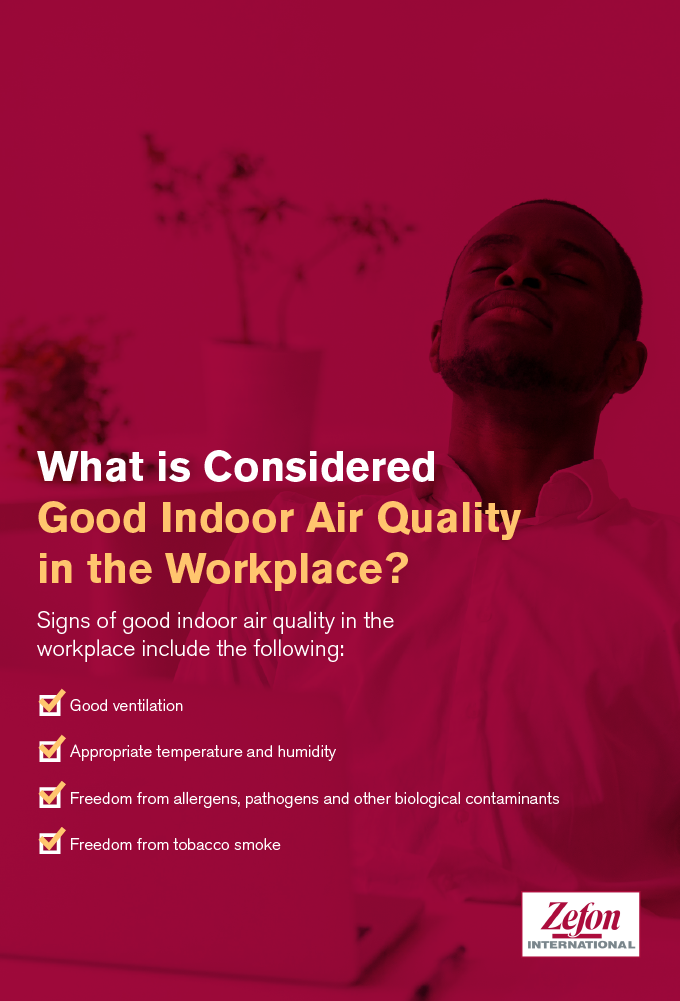
Signs of good indoor air quality in the workplace include the following:
- Good ventilation: The heating, ventilation and air-conditioning (HVAC) system should be in good repair and functioning properly.
- Appropriate temperature and humidity: The temperature and humidity in the building should be set so that employees who are wearing a typical amount of clothing are not too hot or too cold. The environment should be neither swampy nor dry.
- Freedom from allergens, pathogens and other biological contaminants: There should be no dirt, mold, mildew, pollen, dust, bacteria or pest droppings in the environment to cause allergies, respiratory symptoms, skin irritation or flu-like symptoms.
- Freedom from tobacco smoke: Tobacco smoke contains a host of pollutants such as carbon monoxide, formaldehyde, nitrogen dioxide, ammonia, tars and nicotine.
What Are the Most Common Causes of Poor Indoor Air Quality?
Poor indoor air quality commonly results from the following factors:
- Poor ventilation: In 52% of cases, inadequate ventilation is at fault in poor indoor air quality. Poor ventilation can result from a problem with the HVAC system or from poor building design in which the flow of contaminated air channels through workspaces instead of out of the building. Without proper ventilation, pollutants build up in the environment and cause illness.
- Poor temperature regulation: The temperature in a building depends on several factors — indoor sources of heat and cooling such as the HVAC system, exposure to sunlight, the outdoor temperature, insulation and ventilation. If building managers fail to adjust for these temperature factors, the workspace becomes uncomfortably sweltering or chilly.
- Poor humidity regulation: Too much humidity is uncomfortable, and it encourages mold growth and attracts pests. Too little humidity — often a problem in winter, when the heating system dries out the air — causes dry, irritated skin. It can also dry out sinuses and lead to nosebleeds.
- Irregular maintenance of the HVAC, exhaust and ventilation systems: Without regular maintenance, these systems become contaminated, clogged or broken. When they cannot function efficiently, pollutants build up.
- Construction or remodeling: Construction work stirs up dust and other particulates. Particleboard, paint, carpet, adhesives and other construction materials contain pollutants can cause inflammation when they reach the respiratory system or contact skin.
- Improper use of cleaning supplies, pesticides and other airborne chemicals: Using airborne chemicals in high-traffic areas, during peak hours or without proper ventilation reduces air quality and leads to illness.
- Moisture from flooding, leaks or high humidity: The resulting mold proliferates beneath carpet and in ductwork, insulation, showers, and dirty or clogged HVAC drain pans. It produces a musty smell at best and — in the worst case scenario — mycotoxins that are harmful to human health.
- Smoking: Tobacco smoke is a major contributor to poor indoor air quality. Many respirable indoor air particulates — those that can be breathed into the lungs — come from tobacco smoke.
- Volatile organic compounds (VOCs): These compounds — which evaporate at room temperature into the air and can be breathed in — include paints, stains, waxes, cleaners, lubricants, air fresheners, fuels, glues, perfumes and even the chemicals from dry-cleaned clothes. These decrease the air quality in the workplace, especially when combined with improper ventilation.
- Pests: Bat and bird droppings, along with vermin like roaches, rats and mice, cause allergic reactions and spread airborne diseases.
What Are OSHA IAQ Standards?
The 1970 Occupational Safety and Health Act (OSHA) does not mandate a general indoor air quality standard. It provides OSHA air quality guidelines to address common workplace complaints about air quality, and it maintains permissible exposure limits (PELs) for hazardous conditions that may lead to serious physical harm or death.
General Duty Clause
OSHA's section 5(a)(1), the General Duty Clause, requires that an employer "furnish to each of his employees employment and a place of employment that are free from recognized hazards that are causing or are likely to cause death or serious physical harm to his employees." Section 5(a)(2) requires employers to comply with occupational safety and health hazards "promulgated under this act."
OSHA PELs
Most PELs were issued shortly after 1970 and have not been updated since that time. Many individual states and companies supplement them with their own regulations and guidelines. Most OSHA PELs indicate a weighted 8-hour average maximum, though some — as with cyanide — indicate the maximum amount allowed at any time. The PELs below are given in parts per million (ppm) or milligrams per cubic meter (mg/m³):
- Acetone: 1000 ppm
- Arsenic: .5 mg/m³
- Carbon dioxide: 5000 ppm
- Carbon monoxide: 50 ppm
- Chloroform: 50 ppm
- Cyanides: 5 mg/m³
- DDT: 1 mg/m³.
- Grain dust: 10 mg/m³
- Naphtha (coal tar): 100 ppm
- Nicotine: .5 mg/m³
- Nitroglycerine: .2 ppm
- Petroleum distillates: 500 ppm
- Respirable aluminum, graphite, limestone, marble, Portland cement, and plaster-of-Paris dust: 5 mg/m³
- Respirable particulates not otherwise regulated (PNOR): 5 mg/m³
- Respirable vegetable oil mist: 5 mg/m³
Though no enforceable regulation exists, OSHA recommends indoor temperatures of 68–76° F and humidities from 20% to 60%.
What Are the Consequences of Poor Indoor Air Quality?
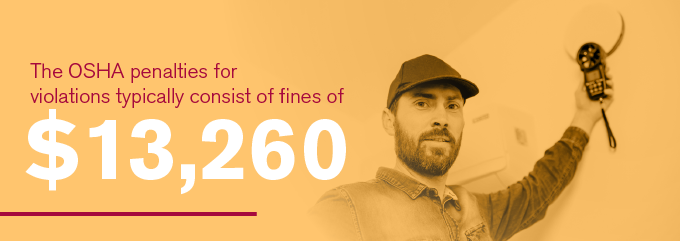
The OSHA penalties for violations typically consist of fines of $13,260. For violations that go unaddressed, the penalties may rise to $13,260 per day until the problem abates. The penalty for a willful or repeated violation increases the base fine by a factor of 10 to $132,580.
While fines for poor air quality at work are hefty, the immeasurable consequences of illness, reduced productivity, decline in employee morale and increased absences are likely to do more damage and cost a workplace more money than the fines themselves. It's essential for employers to know how to avoid OSHA penalties both to avoid fines and to give employees a workplace where they can perform at their best.
How Can I Tell if There Is an Indoor Air Quality Problem in My Workplace?
The air at your workplace may not be meeting OSHA indoor air quality standards if any of the following scenarios apply at work:
- You have unexplained occurrences of eye or respiratory inflammation, skin irritation, dizziness, nausea, fatigue or flu-like symptoms.
- You have symptoms that occur only at work or diminish outside of work.
- Your symptoms started with something new at work, like construction or a new pest control regimen, or are similar to symptoms described by others at your workplace.
- Allergy testing reveals an allergy to specific chemicals found at your workplace.
- Asthma or allergies are worsening without a known cause.
How to Find Indoor Air Quality Problems
There is no single OSHA test to determine indoor air quality. However, if you suspect poor indoor air quality is a problem at your workplace, you can take the following measures:
- Speak with the building manager. Ask for a check of the HVAC system. Request that the building manager do a walk-through of the building to check for water damage, mold, insect or rodent activity and pollution sources venting into the air intake.
- Contact OSHA for an inspection. Employers cannot legally discriminate or retaliate against employees who do so.
- Sample IAQ. Request that your employer arranges to take samples to measure the indoor air quality of the building.
What Should My Employer Be Doing to Prevent Indoor Air Quality Problems?
Employers should take the following preventative measures to avoid OSHA penalties:
- Increase ventilation. There are no specific OSHA ventilation standards for specific cubic feet per minute (CFM), but similar organizations have made recommendations from 5 to 15 CFM per person [IC] for general office space and up to 60 CFM per person if employees are smoking in that area.
- Perform regular inspections.
- Perform preventative maintenance on the HVAC system. Preventative maintenance includes changing filters regularly, cleaning drain pans and lines, fixing leaks, cleaning spills, checking flues and making sure vents are pest-proof.
- Eliminate leaks and standing water. Clean wet areas like showers thoroughly and throw away any water-damaged materials.
- Comply with state-level radon and asbestos testing and requirements.
- Prohibit smoking except in designated areas away from air intakes.
- Keep temperature and humidity within comfortable levels.
- Take samples to measure air quality.

To prevent air pollution from indoor sources, employers should do the following:
- Reduce the use of aerosols and air fresheners.
- Dilute chemical sprays and cleansers per the manufacturer's instructions.
- Use chemicals during low-occupancy periods.
- Store chemicals properly.
- Use high-efficiency vacuum bags and change them frequently.
- Use exhaust hoods in laboratory spaces and kitchens.
- Use pest baits and traps instead of pesticides. When pesticides are necessary, use them in target areas and only during low-occupancy hours.
To prevent pollution from outdoor sources, employers should do the following:
- Use air filters.
- Require engines to be shut off at the loading dock, or use pressurized vestibules and sealed doors near the loading dock.
- Locate air intakes away from sources of pollution, such as incinerators, pesticide sprayers, exhaust vents, and sources of water.
- Make sure the building is pressurized appropriately. A negatively pressurized building will draw in outside air through cracks.
Sampling the Workplace for Indoor Air Quality
What contaminants does OSHA test for? Below you will find some of the types of air toxins that OSHA tests for and recommends sampling to ensure high indoor air quality:
- Acetic acid: Found in X-rays ad silicone caulking, this acid causes eye and respiratory irritation.
- Asbestos: Found in insulation, drywall and plasters, this toxin has no acute effects, but long-term exposure to airborne asbestos causes cancer.
- Carbon dioxide: Found in human respiration and combustion products, carbon dioxide causes difficulty in getting enough oxygen and leads to sleepiness and difficulty concentrating.
- Carbon monoxide: Found in fossil fuel exhaust, carbon monoxide causes dizziness, headaches, nausea, and ultimately cardiovascular impairment and death.
- Formaldehyde: Found in plywood, particle board, carpeting, fabric, glues and insulation, this chemical causes a strong unpleasant odor, skin rashes and eye and respiratory irritation.
- Microorganisms/biological contaminants: These cause allergic reactions, skin, eye and respiratory irritation, and serious illnesses such as hantavirus. Biological contaminants can include anything from viruses, mold and bacteria to pollen, mites, amoebae, and insect and animal droppings.
- Nitrogen oxide: Found in combustion from gas furnaces and appliances, this chemical causes eye and respiratory irritation.
- Ozone: Found in copy machines, electrostatic air cleaners and smog, ozone causes eye and respiratory irritation and exacerbation of chronic respiratory conditions.
- Radon: Found in soil and groundwater, radon has no acute effects, but long-term exposure causes lung cancer.
- Synthetic fibers: Found in fibrous glass and wool, synthetic fibers cause skin, eye and respiratory irritation.
- Tobacco smoke: This toxin in cigarettes and pipe smoke causes eye and respiratory irritation, exacerbates allergies and asthma and can lead to lung cancer.
- VOCs: These cause nausea, dizziness, headaches, fatigue and eye and respiratory irritation.
Several different types of equipment sample indoor air quality to determine whether it meets OSHA air quality regulations, including:
- Sampling Cassettes: These tools come as either preloaded cassettes — which contain a pre-installed filter and require no assembly before use — or reusable unloaded cassettes. Sampling cassettes test for a variety of contaminants and come in a range of diameters for use with different applications. They contain quality adhesives to catch and hold contaminants without requiring cleanup. They require no swabbing or transfer of materials — they can go directly to the lab when full.
- Inhalable Sampler: Unique to Zefon International, inhalable samplers are specifically designed to clip to a shirt collar to measure the quality of the air an employee breathes. They trap respirable particles — typically those measuring up to 100 µm in diameter.
- Nanoparticle Samplers: Nanoparticle samplers are specifically engineered to measure the tiny, nanometer-measured particles generated as a byproduct of nanotechnology. They are meant to be worn and collect particles while an employee works.
- Sampling Pump: Sampling pumps pair with filters and cassettes to collect air from the environment. They are designed for a range of applications, from static use in large areas to being worn for personal sampling on the job. Some are specifically designed for hazardous underground occupations like mining.
- Portable Instruments: Portable instruments include monitors like dust monitors, air quality meters to measure temperature, humidity, air velocity or carbon dioxide concentration, and differential pressure monitors to test for asbestos, lead and mold. Laser particle counters test for tiny particles to make sure no source of poor air quality goes unnoticed.
- Gas Detection Equipment: These tubes and sample bags test for specific gases. Detector tubes change color when exposed to specific gases so that there's no need to wait for laboratory testing, whereas gas sample bags collect air samples for later analysis.
Contact Zefon International, Your IAQ Sampling Equipment Provider
Zefon offers a wealth of state-of-the-art, industry-leading equipment to keep indoor air quality high and employees healthy, comfortable and high-functioning. A small investment in air quality testing leads to immeasurable benefits for health and productivity in the workplace — and Zefon can help your workplace meet OSHA air quality standards to achieve those goals.
To ensure clean, healthy, quality indoor air for your work environment, please get in touch today by filling out the pop-up contact form on our website or calling 1-352-854-8080.

























